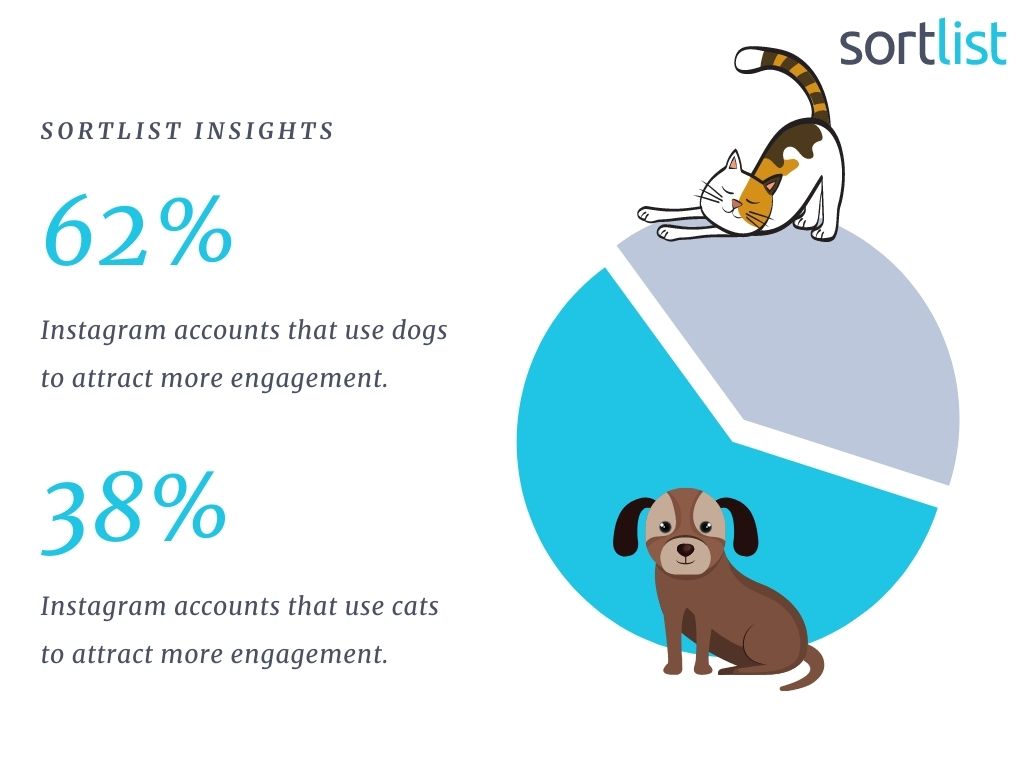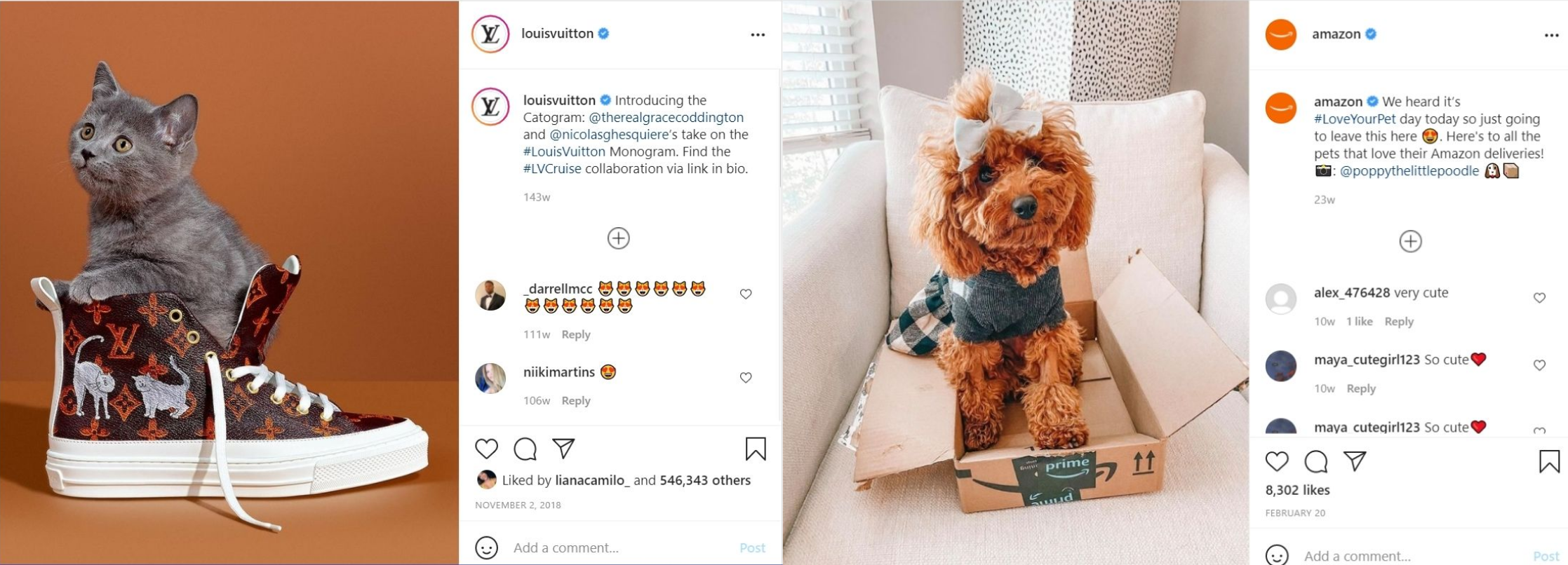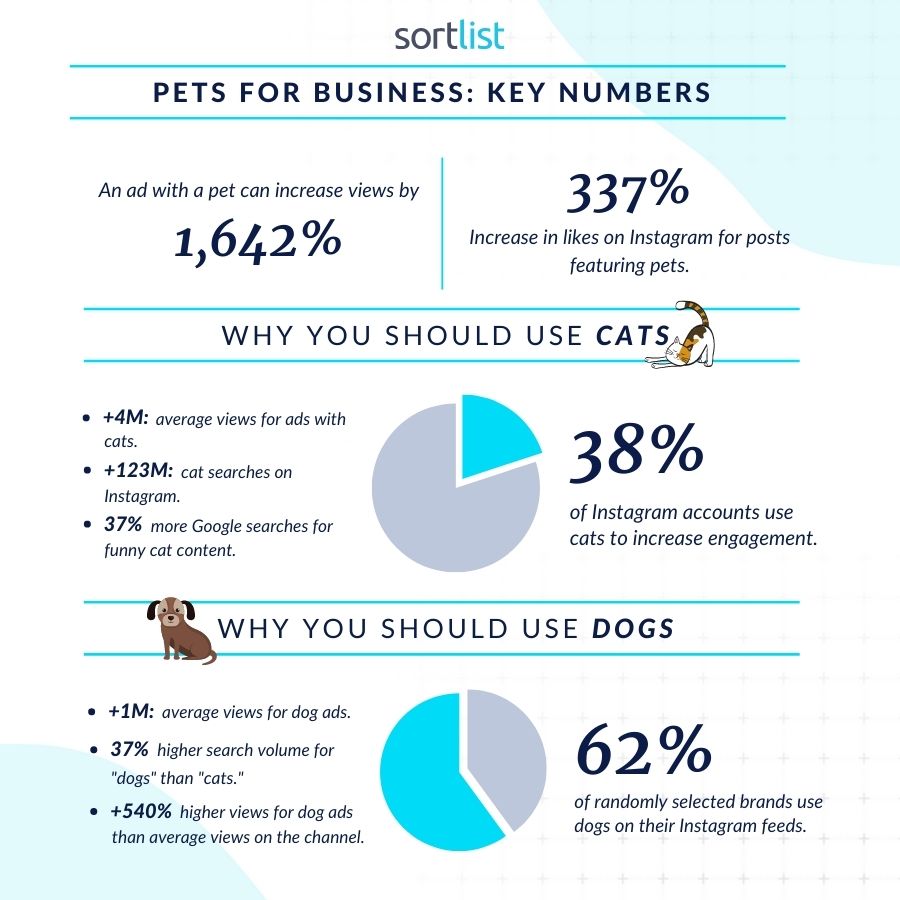
Cats and Dogs Boost Your Business By 300%. Here’s How.
Last update: 27 September 2022 at 06:10 pm
It’s the age-old question that has endured ever since the creation of the internet: are you a cat person or a dog person? Or do you love both cats and dogs?
For brands, the issue may be more than a matter of preference. It turns out that, as cats and dogs have grown in popularity throughout the years, so has companies’ inclination to boost their engagement and visibility with pictures, posts, and commercials featuring the two iconic pets.
It’s a simple redraft of a mathematical law: if A = B and B = C, then A = C. From a business perspective, if users love pets and pets are seen in ads, then users should love the ads, right? Unfortunately, conclusions are never this easy.
We have both dog lovers and cat lovers at Sortlist, so it was only logical that we put the issue to rest. With a pack of data at hand, we wanted to determine how brands have used cats and dogs in their marketing to increase their engagement rate and conclude, once and for all, which of these two is better for business.
Is this catnip to your eyes? Then let’s dive right in.
Cute For Business: How Cats and Dogs Help With Visibility and Engagement
While it’s true that, on social media, rules are rewritten every day, some facts have remained consistent throughout the evolution of the numerous social platforms. One of these facts is that, across all channels, pets have been shown to improve social media engagement rates, which according to Nichefire, can rise up to 63% higher than those for the average business post.
Similarly, a study by NewsWhip revealed that, on average, a brand post with a pet resulted in an increase in comments of approximately 89%, while the average increase in likes was around 19%.
Doron Wolffberg of Cliverse, who does the marketing for some of the online pet space’s best loved brands, says, “Using keyword searches, google trend analytics and user-generated feedback is a great way to determine what content is trending and will best capture the attention of your audience. Current pet content trends include content relating to pet health and supplements, high-end pet products, and pet food niches.”
Our own numbers reveal a similar trend. We analyzed 500 commercials uploaded by brands to Youtube featuring cats and dogs. We made sure not to include ads for cat-related or dog-related products, and just focused on unrelated brands that had opted to include these pets in their advertisements.

Starting in 2021 and going as far back as 2009, we noticed that the cat ads we analyzed have seen a whopping increase of 2,700% views when compared to the average number of views of any single video on the brand’s Youtube channel.
Big names such as Mercedes-Benz, Pizza Hut, Skittles, Netflix, and LG have all jumped into the feline wagon and seen their engagement soar with their cat videos.
Additionally, 32% of the cat commercials belonged to British brands, including Sainsbury’s, Cravendale, and O2, leading us to conclude that the United Kingdom is, without a doubt, a cat nation 😸. It’s followed closely by Germany, whose cat ads represented 20% of our list.

Out of the dog ads we examined, ranging from 2008 to 2021, the increase in views was lower than cats’, but the stat is no less surprising: dog ads accounted for 547.6% more views for their brands on Youtube than the average number of views of any single video on the brand’s channel.
42.8% of the dog videos on our list belonged to brands in the United States, making the star-spangled banner the undisputed king of dog lovers, followed by France with 14%.
Dogs: That’s a Good (Organic) Boy
However, the difference in average views does not mean that dogs are viewed less favorably by brands or users than cats. In fact, these are only commercials, which may point to a clear conclusion: cats look good on film.
But what happens if we run the same experiment with organic social posts? After looking at 400 posts from unrelated dog or cat brands, and comparing them to the average engagement metrics of their last 20 posts, the results look slightly different and a winner is clearly visible.

62% of the randomly selected brands featured dogs in their organic posts, while 37.9% featured cats. The appearance of these pets in the feeds of companies such as Amazon, People Magazine, and Louis Vuitton makes it clear they are a surefire way to make users stop scrolling.
In our study, organic posts that featured both animals saw an increase of 337.4% in likes and 226.9% in comments.
Pets Bred for the Web

Similarly, we decided to perform more than 20 comparison searches in Google Trends to see how both pets ranked in popularity, and once again, dogs came out on top. However, cats reigned more popular in humour-related queries.

The results from our study endorse the report that network Three completed in 2018, which revealed that 90% of people have admitted they are more likely to engage with a post if it shows animals. Is there any psychology behind this furry phenomenon that brands can leverage?
Pets and the Psychology of Viral Content
Search for any cat or dog content online, and chances are you’ll find a video that went viral at one point. Both pets are associated with viral content, which, aside from being massively shared, has been defined as having the ability to trigger specific emotional responses.
Additionally, virality is shown to have a strong connection to positivity, which explains why positive content will likely receive widespread social exposure.
Furthermore, some studies hold that the positive psychological effects that pets have on their owners also hold true for images viewed online. A Japanese study also reported that looking at images of cute animals at work can improve employees’ performance by extending their attention span and inducing them towards careful behavior.
Catvertising
It’s not easy to speak on why cats provide so much allure for us. On Youtube alone there are over 2 million cat videos, with a combined total number of 25 billion views. The digital culture magazine Thought Catalog has described cats as the Internet’s “unofficial mascot.” Similarly, the New York Times has described cat images as “that essential building block of the Internet.”
What’s going on here?
Research suggests there is a strong “before and after” effect when watching cat videos, in which negative emotions are suppressed and positive ones are heightened.
And yet, cats inadvertently became an instant sensation in the online world, creating, in the words of the BBC, “a whole new form of internet speak,” with memes and videos of cats flooding the cyberspace.
“Cats” remains one of the most-searched-for terms on the Internet, and despite the fact that there are more dog-related searches than cat-related searches on Youtube, cats achieve virality on the platform much quicker than dogs do, receiving almost four times as many viral views and placing the feline kingdom at the top of Youtube’s most popular categories.
As if that weren’t enough, just look at what Tim Berners-Lee, the creator of the world wide web, has to say about the matter:
A 2015 study concluded that people are “more than twice as likely to post a picture or video of a cat to the internet than they are to post a selfie,” and ended with a particularly ominous tip: if we want to understand the effects that the Internet has on society, as well as users, then we simply can’t ignore Internet cats.

Dog Days Ahead
Despite all their popularity, cats cannot compete with the kings of social: dogs. On Instagram, there are over 146.9 million dog searches, compared to 123.8 million cat searches. Likewise, there are 23 million more #dog posts than #cat posts, while #DogsOfInstagram trends at 11 million more posts than #CatsOfInstagram.
However, it’s good to note that, while dogs have the advantage on the number of posts, the most famous cats of Instagram have a larger number of followers than the most famous dogs.
In 2018, 22 of the top 50 pet accounts on Instagram were dog-related, compared to 18 that were cat-related.
Another good metric for gauging Internet pet love would be to take a look at Reddit, the so-called “front page of the Internet.” In the /r/aww subreddit, the community of cute photos and videos with over 16 million subscribers, more than half of the top 100 posts between 2008 and 2017 featured dogs.
Is There A Clear Winner?
At the beginning of this piece, we set out to put the most important debate of our generation to rest. The trend is clear for us: cats make your ads look good, and dogs make your feed stand out from the crowd.
It’s no surprise then to see more viral views from cat videos than from dog videos. For the average cat post, that’s approximately 9,000. For dogs, it’s only about 5,000.
Furthermore, if the numbers for the top 5 purrforming cat posts since 2011 are added up and compared to the top 5 performing dog posts, cats have their paws firmly gripping the top spot: +2,600,000 viral views, almost 2 million more than the top dogs, who come in at a feeble 700,729 views.
Across countries, the battle ensues just as fiercely. A report by Budget Direct claims that cats are more popular than dogs in 91 countries, and dogs more popular in 76 countries.
However, preference for dogs is expanded through more continents, outweighing cats in North and South America, Oceania, and Africa. Europe and Asia are cats’ realms.
From a local perspective, New York City had the highest number of cat- and dog-tagged photos in the world, and 59.6% of those posts were about cats.
Similarly, five cities in Germany (Koblenz, Straubing, Hanau, Theuma, and Oldenburg), two in France (Deauville and Saint-Denis-de-Pile) and two in Spain (Valdemoro and Pontons) are 100% dog lovers.
Four cities in the Netherlands (Hoofddorp, Brielle, Gorinchem, and Vries) and another two in France (Ramatuelle and Mouzillon) are cat lovers through and through.
Business’ Best Friends
It stands out as one of those new, unwritten laws of the digital world: if you want to increase your social media presence, get a pet. Whether it’s the next big creative campaign for your brand or a “Bring a Pet to Work” day for your employees, these two furry fellas can help you gain the traction you need and engage your community in ways you had never imagined.
Just remember: you should always be posting content that your audience wants to see. More often than not, people don’t go into social media to be sold to, but with the proper triggers, copy, a wagging tail and a pair of unblinking eyes, your posts and ads will have your followers howling for more.






